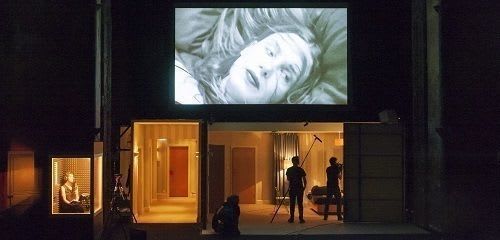Marguerite Duras’s brief, haunting prose-poem La Maladie de la mort consists simply of a contract, the subject of which is a woman’s body. The Man—played by Nick Fletcher in this adaptation of Duras’s text by director Katie Mitchell and adaptor-translator Alice Birch at the Barbican Theatre (and first seen in Edinburgh earlier this year)—pays The Woman, Laetitia Dosch, to come to his room for three nights and have sex with him, so that he might learn to know love and feel desire.
The Woman plays her role to perfection, fulfilling the terms of the exchange and collecting her renumeration. Despite their erotic interactions, described with graphic realism by Duras, The Man remains dissociated, his obsessive epistemophilia frustrated, his ‘gaze’ ignorant and impotent. He is unable even to see that he cannot ‘see’ The Woman, and so she eludes his visual grasp and denies him power. When she disappears, of her own accord, she denies him—the narrator in Duras’s text—his ‘rightful’ ending: her death at his hands.
Duras’s experimentations in film and theatre during the 1970s influenced the literary work she produced subsequently; some critics have described La Maladie de la mort as hybrid récit-théâtre and when it was published in 1982 it included an appendix containing directions for staging. The second-person narrative voice creates a frame, evoking perhaps a director giving instructions to an actor, while the perspective infers the reader’s complicity.
It’s no surprise, then, that Duras’s text has invited theatrical adaptation. Robert Wilson’s movement- drama-sound interpretation appeared in the late 1990s. Now, Mitchell has developed the ‘watching you, watching me’ trope by presenting synchronously the staged events in the shadowy room and a live cinematic unfolding of this action, in grainy monochrome, above.
We thus see on film what we can’t see in the theatre: sliding doors and darkness obscure our vision of the semi-pornographic encounters between The Man and The Woman, as simultaneously they are exposed, literally, to our gaze on the screen above. Perhaps drawing on the narrative framing of the original, Irène Jacob recites the French text from a small recording booth stage-right, as subtitles of Birch’s English translation are projected.
There’s no doubt that Mitchell and her set, sound, video and lighting designers (Alex Eales, Donato Wharton, Ingi Bekk and Anthony Doran respectively) have created a sophisticated mise en scène, and the technical wizardry (video director Grant Gee) is both imaginative and skilful. But, Duras’s melodious poetry is overpowered by a stage cluttered with camera crew and assorted techies, busily re-arranging equipment, wires and props, and the only way I could avoid the agitation of this visual ‘noise’ was to focus on the screen above—where the fruits of the techies’ labours were in evidence: surely not what Mitchell intended.
The film takes us beyond the theatre: into the elevator, out onto the street, back to The Woman’s childhood—a seminal event is revisited. A panorama of an ocean conjures the passing of time and reminded me of the opening up of space, from claustrophobic and cruel confines, at the end of Ôshima’s Ai no corrida.
And if, essentially, Mitchell emphasises the male view that dominates the novella (she seems to suggest that The Man is a porn addict), focusing with sometimes painful explicitness of parts of Dosch’s body, she does not neglect the power of the female gaze. Fletcher’s body, too, is meticulously scrutinised by the camera and towards the end, after an outburst of violent impotence, he is the ‘victim’ of The Woman’s caustic castigation of the barrenness of his desire and the desolation of his soul.
Which brings us to Duras’s title: what is this ‘death’ that is a sickness? Even allowing for Duras’s characteristic ambiguities, Mitchell evades defining ‘la mort’. If we look at the context of Duras’s other work and own interviews and writings, we might feel that what La Maladie de la mort is interrogating is the relationship between heterosexuality, homosexuality and homo-social malaise.
In interviews during the 1970s, Duras aligned male homosexuals and women in their opposition to the ‘la classe phallique’, but later she suggested that heterosexuality had a monopoly on a desire which is necessarily and solely born of sexual difference. Precluded from desire, and thus creativity, male homosexuals are, according to a comment Duras made in 1988, exiled—‘dans un exil plus profond que les autres hommes’—socially and sexually dislocated.
In La maladie de la mort, Duras infers that The Man is homosexual—it is his narcissistic solipsism that is ‘la mort’, a deathly sickness caused by his failure to acknowledge and see the female otherness upon which masculine desire is fed. (The inferences are confirmed by Duras’s Les Yeux bleus cheveux noirs, a re-visitation of La Maladie written four years later, in which The Woman is involved with two men, one homosexual and one heterosexual, and which quotes directly from the earlier text.)
Mitchell seems disinterested in such philosophies and more concerned with social realism. Although Duras’s narrator relates a ‘histoire d’un enfant’ to the sleeping woman, Mitchell chooses to give The Woman alone a back-story: in addition to the distressing, formative event of her childhood, she’s a single-mother and thus there is an economic imperative and justification for her prostitution.
The problem is that there is no progression or development—of narrative, character, emotions. An unchanging sequence of ‘paid nights’ unfolds. The co-signatures of the contract are equally emotionally sterile and atrophied. They speak but not ‘to’ each other. There is a theatrical inertia which is indeed deathly.
